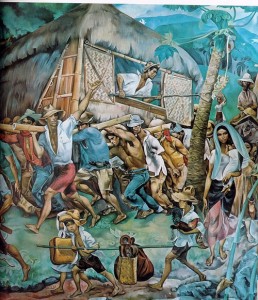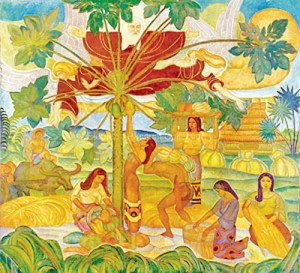Botong’s first solo exhibit
Botong’s first solo exhibit
By Jasmine T. Cruz
Botong Francisco: A Nation Imagined
Ongoing until March 31
Ayala Museum, Makati Ave.
corner De la Rosa St.,
Greenbelt Park, Makati City

BAYANIHAN by Carlos “Botong” Francisco, 1962, Oil on canvas, 544 cm. x 544 cm. United Laboratories Collection
IT MAY SEEM ODD, but National Artist Carlos “Botong” V. Francisco never had a solo exhibit of his works in his lifetime.
So the exhibit Botong Francisco: A Nation Imagined, on view at the Ayala Museum, will be the artist’s first, said Maria Bernadette “Ditas” Samson.
To celebrate the birth centenary of the artist from Angono — who was posthumously named National Artist in 1973 — the Ayala Museum gathered 40 works from several public and private collections for the exhibit.
The exhibit will also give museum goers a glimpse into Mr. Francisco’s artistic process by showcasing studies and sketches that have never been seen in public before.
This exhibit is part of the museum’s Images of Nation, a project that celebrates the work of National Artists in the visual arts, and the exhibit is also one of the events in the year-long centennial celebration organized for Mr. Francisco.
Once the exhibit at the museum ends, selected works will be featured at Ayala Malls and partner schools across the country.
Cinema and modern art
Mr. Francisco is best known for his large-scale murals like Manila City Hall’s 500 Years of Philippine Progress, Malacañang’s Fiesta, and the National Museum’s four-panel History of Medicine (held in trust for the Philippine General Hospital).
To capture these famous works, the museum tapped director Peque Gallaga to produce a 15-minute film that showcases these murals. In the film, actors reenact the famous scenes depicted by the artist, then the actors freeze and turn into the painted figures in the murals.
Ms. Samson explained that the film harkened to the time when Mr. Francisco worked as a set and costume designer for Manuel Conde’s films in the 1950s. Their most famous collaboration was Genghis Khan, which competed at the 1952 Venice Film Festival.
Another notable collaboration was with his Fine Arts professor Victorio Edades and another young artist Galo Ocampo. Representing their work, the exhibit currently shows the trio’s Mother Nature’s Bounty Harvest.
The group was known as the “Triumvirate of Modern Art” as they instigated a rebellion against the prevalent romantic realism championed by National Artist Fernando Amorsolo. In portraying images of struggle and brutality, they ushered in an era of modernism, an artistic movement that was highly influenced by the World Wars.
In an e-mail interview with BusinessWorld, the artist’s eldest child, Carmen Francisco Whalen, said that World War II affected her father and Angono deeply.
“Houses were burned, including the ancestral home that we had,” she wrote.
Recalling stories from the past, Ms. Whalen talked about how the artist’s uncle was imprisoned in Fort Santiago and eventually killed, and that her father experienced retreating to the mountains to hide from the Japanese.
She said that her father depicted strong men, but their faces often showed that they are “suffering due to hard labor.”
“This expression is a result of a people affected by war and poverty,” she said. “Yet they are graceful, beautiful, and hopeful, as shown in his lines and colors.”

MOTHER NATURE’S BOUNTY HARVEST (INTERACTION) by Victorio Edades, Carlos “Botong” Francisco, Galo Ocampo; ca. 1935, Oil on canvas, 255 cm. x 271 cm. Dr. Eleuterio Pascual Collection
Remembering Botong
Artist Salvador “Badong” Juban spent a large portion of his life working with the National Artist. He said that he had already been studying Mr. Francisco’s paintings as a boy. Finally, in high school, he mustered the courage to approach Mr. Francisco, show his own works, and ask for an autograph.
“Umpisa nun, nasa bahay niya ako araw-araw (Ever since then, I went to his house every day),” Mr. Juban told BusinessWorld during the exhibit’s opening on Dec. 3.
Despite Mr. Francisco’s celebrity status, he never made the young Juban feel inferior. “As a teacher rinerespeto ka niya (he respects you),” Mr. Juban said. “Kapag rine-touch niya ’yung gawa mo, apologetic siya. Sasabihin niya, ‘Inayos ko lang, pero OK ’yang ginawa mo’ (If he’d retouch your work, he was apologetic about it.
He’d say ‘I just fixed it, but what you did was good’).”
Mr. Juban was full of tales about his old mentor, and told one about the National Artist’s love for animals. The apprentice recalled how one night he visited Mr. Francisco’s studio and heard his mentor saying “Oh, nand’yan ka na naman (Oh, you’re here again).” Young Juban asked, “Ninong, sino kausap mo (Uncle, who are you talking to)?” Mr. Francisco responded, “Kaibigan ko (my friend),” pointing to a frog.
It turned out that Mr. Francisco rescued the creature who was trapped in a jar. “Mula noon, tuwing gabi dinadalaw siya nung palaka (Ever since then, the frog would visit him at night),” Mr. Juban said.
One time Mr. Fransisco got sick, so his doctor told him to eat a dove to regain his strength. Mr. Francisco’s wife had a hard time looking for one. After a long search, she found a dove in Pasig. However, when Mr. Francisco saw the bird, he did not want to eat it.
“Pinagawan pa niya ng bahay (He asked someone to make a house for the bird),” said Mr. Juban.
Creative process
There are people who describe Mr. Francisco as a “lazy artist,” said Mr. Juban, but he disagrees. “Minsan sasabihin ng asawa niya, ‘Magpinta ka na Botong at wala na tayong pera’ (Sometimes his wife would tell him, ‘Botong, please paint already, we are running out of money’),” Mr. Juban said. “Tawa lang siya (He’d just laugh). But he was not lazy. He was moody. You can’t do work every day like a machine.”
The artist’s daughter Ms. Whalen said that the reason Mr. Francisco took a long time to begin a painting was because he would think about the idea over and over again before he’d touch the canvas. She said her father would research the subject matter and talk to the people in Angono. “When the time was ripe, he’d work on it for hours,” she said.
“Kita mo naman sa murals niya, ang lalaki. So, how can they say he was lazy? ’Pag OK na siya di mo siya maaawat (Look at his murals, they are so big. So, how can they say he was lazy? When he was OK, you couldn’t stop him),” Mr. Juban added.
Given the amount of time he’d devote to his paintings, Mr. Francisco had a hard time parting with them. Mr. Juban said that his mentor considered his paintings as his children. The apprentice remembered how Mr. Francisco cried when he had to part with Mutya ng Pasig. A watercolor version of this painting is currently on view at the Ayala Museum.
“Tinititigan niya ’yun bago matulog (He would look at it before he’d go to sleep),” Mr. Juban said, “’Nung dineliver, ayaw niya umalis. Sabi ng bumili, ‘’Wag ka mag-alala, ’yung pagmamahal mo para diyan, dodoblehin ko’ (When it was delivered, he didn’t want to leave. The one who bought it said, ‘Don’t worry. Your love for it, I will double’).”
BUSINESS WORLD
Comments (0)